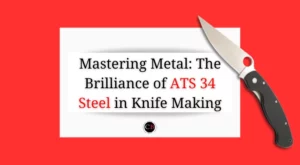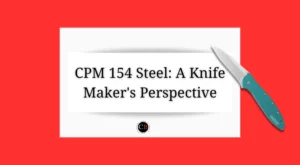Ever wondered if CPM 3V makes a great knife? Well, let’s chat about it! In the world of knives, people often ask “Is CPM 3V a good knife steel?”. I am going to talk about what makes this steel special and whether it’s a top choice for knives. Is it truly the game-changer in the world of knives?
Let’s explore the exceptional attributes and potential that make CPM 3V a compelling choice for those seeking a cut above the rest.
Table of Contents
What is CPM 3V steel?
CPM 3V, also known as 3V steel, stands out as an exceptionally robust and wear-resistant tool steel meticulously crafted for applications like punching dies and cutting tools. It excels in safeguarding against breakage and chipping, making it a top choice for knives, cutters, and scrap shredders where durability is paramount.
3V steel, crafted by Crucible Industries LLC in the United States, stands as a high-carbon tool steel distinguished by its unique manufacturing process. Utilizing Crucible Powder Metallurgy (CPM) technology, this steel undergoes a revolutionary method that guarantees an impeccable uniform distribution of carbides, resulting in enhanced strength compared to traditional approaches.
Renowned for its impeccable blend of characteristics, 3V steel boasts exceptional toughness and high wear resistance. Classified within the tool steel category, it aligns itself with esteemed counterparts like O1 and D2, solidifying its place among the elite in the realm of tool steels.
Crucible has developed this steel to maximize resistance to chipping and fracture in high-wear situations. Common applications include punches, dies, punching tools, shear blades, and any industry requiring high toughness. Due to its resilience, it is also used in sword and large knife manufacturing and excels in fixed-blade knives.
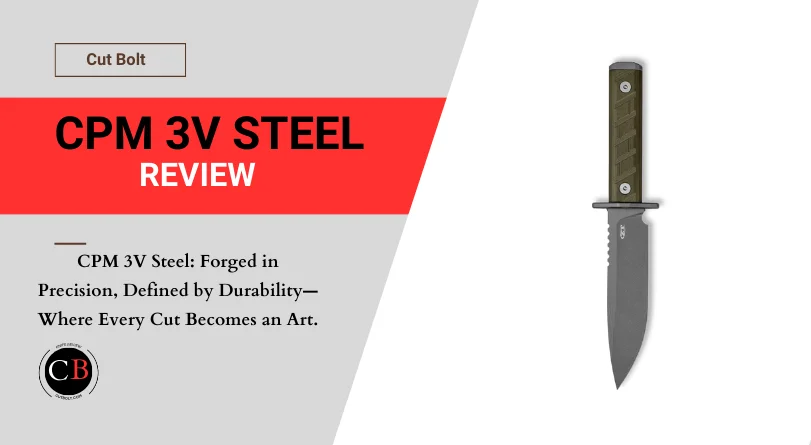
Chemical composition of CPM 3V steel
| Element | Portion | Effect |
| Chrome | 7.5% | Improves wear resistance, heat resistance and scale resistance. It increases tensile strength because it acts as a carbide former. Use of rust-proof or stainless steel, as it increases corrosion resistance from a mass proportion of 12.2%. Reduction in weldability. |
| Carbon | 0.8% | Increasing hardness and tensile strength. In larger quantities, increase in brittleness and reduction in forgeability and weldability. |
| Manganese | 0.4% | Improves hardness and tensile strength. |
| Molybdenum | 1.3% | Improves hardenability, tensile strength and weldability. Reduction in forgeability and ductility. |
| Phosphor | 0.03% | Increases tensile strength, hardness and corrosion resistance but also brittleness. |
| Sulfur | 0.03% | Increases machinability but also brittleness. |
| Silicon | 0.9% | Improves strength. |
| Vanadium | 2.75% | Increasing hardness, increasing wear resistance and improving tempering resistance. |
| Wolfram | 0.4% | Increase in heat strength, tempering resistance and wear resistance at high temperatures up to red heat. |
As you can see 3V steel has 7.5% chromium and 0.8% carbon with 2.75% vanadium, which makes it a tough tool steel with good corrosion resistance.
Is 3V stainless steel and/or rustproof?
3V tool steel is neither rustproof steel nor a stainless steel. To be considered rust-free it would require a chromium content of at least 10.5 – 13% chromium dissolved in the austenite or ferrite, depending on the definition (see here).
CPM 3V is not a stainless steel either because its sulfur and phosphorus content (so-called iron companions) exceeds 0.025% (see here).
What is the hardness (HRC) of CPM 3V steel?
According to Crucible, the maximum hardness of CPM 3V is a Rockwell hardness of 58-60 HRC. This is exactly what knife steel experts recommend as the perfect hardness for a good knife steel (i.e. high 50s and low 60s). The good hardness gives CPM 3V steel knives excellent wear resistance and edge retention.
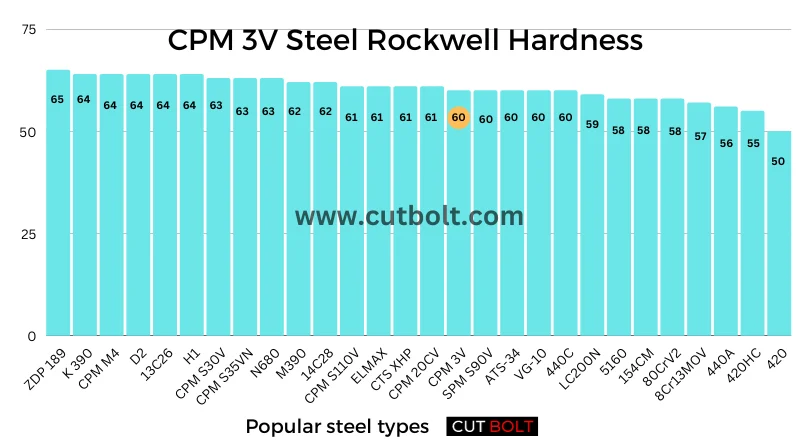
Properties of CPM 3V steel
According to the chemical composition and hardness of CPM 3V, it offers:
Edge retention
With a maximum working hardness of 60 HRC, this steel offers excellent edge retention, outperforming tool steels such as D2 and A2. However, it may not hold its sharpness quite as well as premium steels (CPM S30V, CPM S35VN, or similar).
Corrosion resistance
3V also offers good corrosion resistance. This is great considering that it is tool steel (which actually has rather poor corrosion resistance in itself) and not rust-free steel. Its good corrosion resistance makes it suitable for outdoor use without being immediately affected by the elements.
Does this mean that CPM 3V will not rust? No. This steel is not optimized for corrosion resistance, so it may rust if exposed to the elements for long periods. Proper care is the key here to prevent corrosion.
Additionally, coatings such as PVD (“Physical Vapor Deposition“,) and DLC (“Diamond-like-Carbon“,) can also improve the corrosion resistance of 3V steel knives.
Even though CPM 3V steel is not rust-free steel, the chromium content of more than 7% makes it highly resistant to corrosion.
Wear resistance
CPM 3V steel is characterized by its high wear resistance. As mentioned earlier, this steel was specifically developed by Crucible for superior toughness and high wear resistance. Its alloy contains high levels of carbon and vanadium, resulting in the formation of harder vanadium carbides. This makes the steel more wear-resistant and harder than steels with fewer or no vanadium carbides.
Toughness
3V is an insanely tough steel! It is the toughest grade compared to other tool steels such as D2 or A2 and possibly one of the toughest steels around.
The steel was developed for applications that require superior toughness and resistance to chipping, replacing other tool steels that tend to do so.
Because of this superior toughness, 3V is often used to make camping or bushcraft knives suitable for splitting logs (“batoning“) and other difficult tasks.
Sharpening
The sharpening rule is quite simple: the harder the steel, the harder it is to sharpen. Sharpening a 3V steel knife takes time and effort and requires harder abrasives. Most manufacturers agree that for best sharpening results, their factory-ground 3V knives must go through a 1500 grit rather than the usual 600 grit. This clearly shows that some effort is required to give a CPM 3V tool steel blade a sharp edge.
However, this does not mean that the sharpness of a 3V blade cannot be restored once it has become dull. If sharpening is done using the right sharpening equipment, any knife will regain a sharp edge.
Forging
Can CPM 3V steel be forged? Definitely yes. 3V steel is forgeable. The secret is finding the perfect temperature range for this steel. However, you should remember that as an air-hardening steel, forging 3V can be difficult and requires a more complicated annealing process than oil-hardening steels.
Machinability
CPM 3V steel machines well and is comparatively, i.e. relative to its classification, easy to grind.
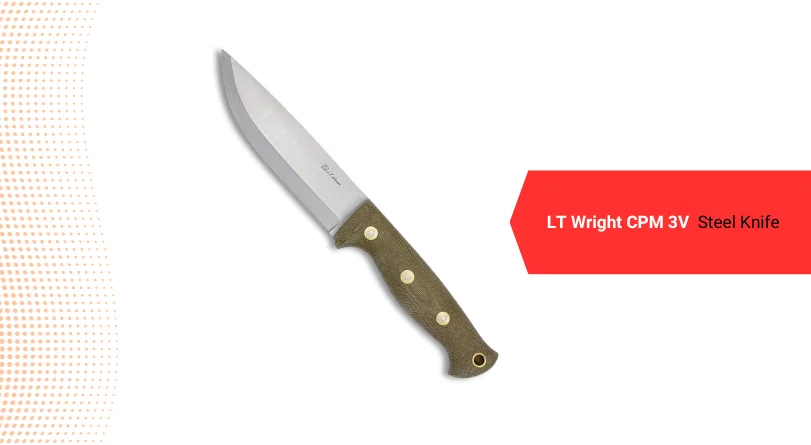
Is CPM 3V a good knife steel? – My opinion
Great edge retention, high wear resistance, excellent toughness with good corrosion resistance – of course, the answer is YES! CPM 3V steel is an excellent knife steel. At least for those who want a very tough knife with good edge retention, this would be (the) steel of choice.
CPM 3V Steel equivalents
As a high carbon and vanadium tool steel, the two most obvious alloys I can think of are D2 and Cru-Wear. All three steels are very wear-resistant and very tough tool steels, although D2 steel has much higher corrosion resistance (some consider D2 steel to be stainless steel) but is much less tough. Cru-Wear on the other hand is even tougher than 3V and also more wear-resistant – making it even more challenging (difficult) to sharpen.
Vasco Die steel
Vasco Die was invented in 1964, a steel that can rightfully be called the father of 3V steel.
Although this steel is no longer produced, it is chemically similar to 3V steel and was originally developed for high working hardness, toughness, wear resistance and good corrosion resistance – i.e. very similar properties to 3V. The steel later also served as a direct predecessor to CPM 3V steel, although the element tungsten was added to it.
Comparison of CPM 3V vs other popular steels
CPM 3VSteel vs CPM S30V
CPM S30V far surpasses 3V with its superior toughness and great edge retention. However, S30V has better corrosion resistance than CPM 3V. Overall, 3V offers better performance than S30V unless you place a high value on high corrosion resistance.
CPM 3V Steel vs CPM S35VN
Just like its “smaller brother” CPM S30V, CPM S35VN offers better corrosion resistance than 3V. However, in terms of toughness, CPM 3V is better. In addition, 3V is less expensive than S35VN. The good news, however, is that both steels offer nearly identical snap strength.
CPM 3V steel vs A2
A2 is a popular tool steel with extremely high toughness and good cutting ability. However, 3V offers even higher toughness than A2. In addition, A2 and 3V share the same properties in terms of sharpness, corrosion resistance and sharpenability.
CPM 3V steel vs D2
D2 is a popular tool steel, just like 3V. Compared to each other, both steels exhibit similar corrosion resistance. However, 3V steel outperforms D2 steel due to its better edge retention and better toughness.
CPM 3V steel vs. CPM M4
CPM M4 is also manufactured by Crucible Industries using their PM technology. CPM M4 only outperforms 3V in terms of better edge retention. Otherwise, 3V outperforms it in all other disciplines, including toughness, corrosion resistance and the ease of sharpening.
CPM 3V steel vs 1095
1095 is a high-carbon steel that is very popular in the knife industry. 1095 is not inferior to CPM 3V in terms of edge retention and toughness. 3V also offers slightly better corrosion resistance than 1095, but 1095 is easier to sharpen than 3V.
CPM 3V steel vs ELMAX
ELMAX offers better corrosion resistance and slightly higher edge retention than 3V. While it also offers high toughness, 3V still outperforms it. Overall, ELMAX’s focus is on corrosion resistance and cut resistance, while 3V’s focus is more on cut resistance and toughness. A purchase decision will ultimately depend on whether the plus in corrosion resistance is the deciding factor.
CPM 3V steel vs CPM 154
CPM 154 offers high corrosion resistance because it has a high chromium content (up to 14%). However, CPM 3V is better than CPM 154 when it comes to maintaining its sharpness and not breaking or splintering on impact.
CPM 3V vs Bohler M390
Böhler M390 is also a very popular steel in the knife market. And more importantly, it is a super steel! It offers excellent performance in all areas, making it a well-balanced steel for knives. Although it offers high toughness, it still doesn’t come close to what you get with the 3V. On the other hand, M390 does outperform 3V in terms of corrosion resistance and edge retention.
Conclusion: Is CPM 3V a good knife steel?
This article is based on many hours of research and my personal assessment. For me, CPM 3V is an excellent knife steel with a wide range of applications, but it is certainly not the very best knife steel there is.
Because the BEST knife steel depends very much on individual needs and possibilities (budget!). It’s a great knife steel and definitely worth owning. However, it is a great knife steel and worth owning in any case.


